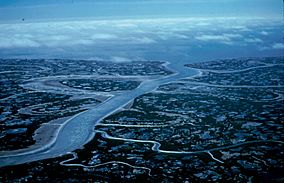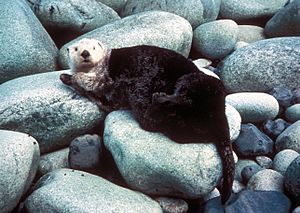Yukon Delta National Wildlife Refuge facts for kids
Quick facts for kids Yukon Delta National Wildlife Refuge |
|
|---|---|
|
IUCN Category IV (Habitat/Species Management Area)
|
|

Brant goose nesting area
|
|
| Location | Alaska, United States |
| Nearest city | Bethel, Alaska |
| Area | 19.16 million acres (77,500 km2) |
| Established | 1980 |
| Governing body | U.S. Fish and Wildlife Service |
| Website | Yukon Delta NWR |
The Yukon Delta National Wildlife Refuge is a United States National Wildlife Refuge covering about 19.16 million acres (77,500 km2) in southwestern Alaska. It is the second-largest National Wildlife Refuge in the country, only slightly smaller than the Arctic National Wildlife Refuge. It is a coastal plain extending to the Bering Sea, covering the delta created by the Yukon and Kuskokwim rivers. The delta includes extensive wetlands near sea level that are often inundated by Bering Sea tides. It is bordered on the east by Wood-Tikchik State Park, the largest state park in the United States. The refuge is administered from offices in Bethel.
U.S. President Theodore Roosevelt first set aside southwestern Alaska refuge lands in 1909. Other lands were added through the years until December 2, 1980, when President Jimmy Carter signed the Alaska National Interest Lands Conservation Act (ANILCA) into law, which created the Yukon Delta National Wildlife Reserve by consolidating existing refuges and adding additional lands. The large islands Nelson and Nunivak are also located within the refuge. In 1968, the Clarence Rhode National Wildlife Range was designated as a National Natural Landmark by the National Park Service.
It is home to about 35 villages and 25,000 people, many of Yup'ik Eskimo origin and dependent on a subsistence lifestyle.
Wildlife

The refuge's coastal region bordering the Bering Sea is a rich, productive wildlife habitat supporting one of the largest concentrations of water fowl in the world. This national wildlife refuge is home to mammalian species such as muskrat, brown bear, muskoxen, moose, black bear, coyote, Canadian lynx, porcupine, beaver, two species of fox, river otter, marten, wolverine, mink, polar bear, and wolf packs. More than one million ducks and half a million geese use the area for breeding purposes each year. There are also very large seasonal concentrations of northern pintails, loons, grebes, swans and cranes. Often, some of the 150,000 plus Mulchatna caribou herd migrate onto the eastern tundra areas during the fall and winter. Walruses, seals, and porpoises can be found in the waters as well as beluga, gray, and minke whales.

